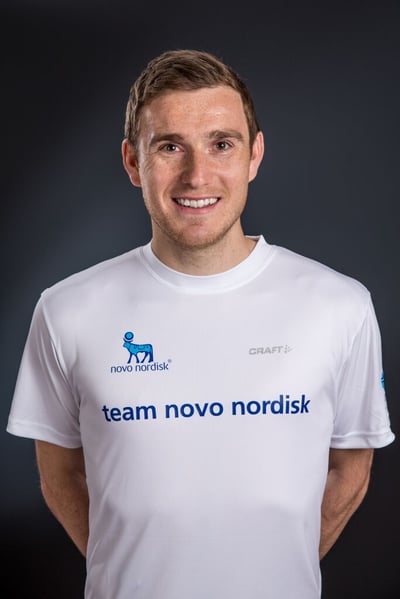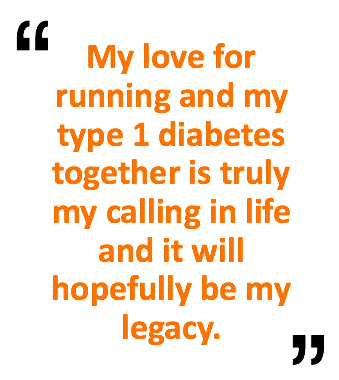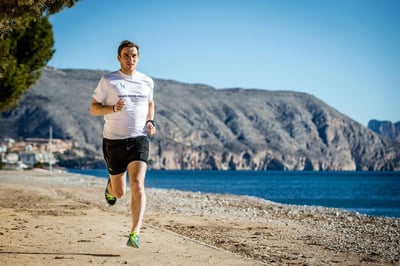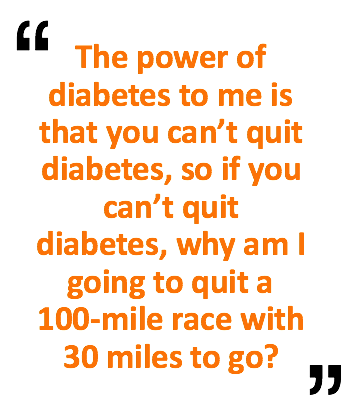Team Novo Nordisk’s Stephen England: Running 100-Mile Marathons with Diabetes
By Lynn Kennedy
 Stephen England discusses balancing elite ultramarathon competitions with a full-time job and diabetes
Stephen England discusses balancing elite ultramarathon competitions with a full-time job and diabetes
The diaTribe team recently caught up with star ultramarathoner Stephen England, though how he managed to spare the time for an interview, it isn’t clear!
Stephen competes in ultramarathon running – basically, anything longer than a 26.2-mile marathon – for Team Novo Nordisk (TNN). The team of professional endurance athletes shares the ability to excel at the highest levels of competition and diagnoses of type 1 or type 2 diabetes. Spearheaded by the its professional cycling team, many of TNN’s nearly 100 athletes balance full-time jobs with their athletic careers in the triathlon, mountain biking, cycling, and running. Take Stephen: he often wakes up at 5 a.m. to train in New York City’s Central Park before heading off to work as a general contractor, making time for travel and competitions on weekends.
For an athlete with a sterling running resume, including a first place finish in the 2012 50 km North Face race and completion of the inaugural 200-mile ultramarathon around Lake Tahoe, Stephen talks humbly about his upbringing, training, and success. Throughout races and life events off the course, Stephen carries with him a strong resolve, centered on diabetes: “If you can’t quit diabetes, why am I going to quit a 100-mile race with 30 miles to go?”
 Stephen shares his story across social media under the name “Rundiabetes”, using his running success as a platform from which to build diabetes awareness and prove anything is possible with diabetes. In his own words, “My love for running and my type 1 diabetes together is truly my calling in life and it will hopefully be my legacy.”
Stephen shares his story across social media under the name “Rundiabetes”, using his running success as a platform from which to build diabetes awareness and prove anything is possible with diabetes. In his own words, “My love for running and my type 1 diabetes together is truly my calling in life and it will hopefully be my legacy.”
To hear more about Stephen’s story and how he balances extreme athletic competitions with a full-time job, family, and diabetes, read on!
Interview
Q: Can you describe your journey to the successful athletic career you have today?
Stephen: Growing up, I was very active and played numerous sports. I found that running was my calling at a very young age.
After my diagnosis at age 14, I was in hospital for about four days. One day, the main doctor was doing the rounds and I asked him, “Can I still be athletic? Can I still be a runner? My grandparents said I can make the Olympics. Can I be in the army?” The doctor basically shot me down right there on the spot with, “I don’t think you understand. This is a really serious condition, and I don’t think you’ll be able to achieve some of the dreams that you wanted to do.” Those words were a hundred times more devastating for me than being told I have type 1 diabetes. That was kind of rock bottom.
One of my dreams that I took back from my doctor because I didn’t want to let him win was to move to New York City and just work there for a year or two and see what that was about. There I found Central Park – it was like the oasis I was looking for. There were so many runners in that park. It just felt like my calling was there, like I’d come here for a reason: to get healthy again, to really control my diabetes, to be active, to regain my love for running that I had when I was a lot younger.
That grew through the years: I did 10 k’s, I did half marathons, then the marathon called. I did the New York City Marathon in ’09 and I got a Boston qualifier from that race (which was really the plan, and it paid off). The next year I went to Chicago and I ran a sub-3 hour marathon – a really big achievement to get a sub-3 so quickly into marathon running.
Q: How did you get started with TNN?
 Stephen: At this point, a running friend of mine said to me, “Have you heard about this team? They’re called Team Type 1 (the predecessor to Team Novo Nordisk) and right now they’re running a 12-person relay from LA to New York City. They’re raising diabetes awareness to show that you can still pursue your dreams with type 1 diabetes. Why are you here training with me right now when you’re not with these 12 guys in the middle of the USA doing this amazing awareness event?” I just didn’t want the spotlight. I was a very, very private person with diabetes up to this point, which was over 15 years by now. My running was more of a public thing. He said to me, “I think you should probably reconsider. You’ve got the potential to really help change what’s going on in diabetes and be an inspiration.”
Stephen: At this point, a running friend of mine said to me, “Have you heard about this team? They’re called Team Type 1 (the predecessor to Team Novo Nordisk) and right now they’re running a 12-person relay from LA to New York City. They’re raising diabetes awareness to show that you can still pursue your dreams with type 1 diabetes. Why are you here training with me right now when you’re not with these 12 guys in the middle of the USA doing this amazing awareness event?” I just didn’t want the spotlight. I was a very, very private person with diabetes up to this point, which was over 15 years by now. My running was more of a public thing. He said to me, “I think you should probably reconsider. You’ve got the potential to really help change what’s going on in diabetes and be an inspiration.”
I left that conversation and in the same week, on the wall at my endocrinologist’s office, there was a poster that said, “Control diabetes, don’t let diabetes control you.” It’s kind of a very standard, almost a very boring thing. But I thought, “Run diabetes, don’t let diabetes run you.” That was how I grabbed the name Rundiabetes for all of my social media.
I then picked basically the hardest race I could find in America, which was Leadville 100 in Colorado [A 100-mile running race at altitude!]. I thought it would be huge for diabetes to show people that I could do something that extreme in endurance with type 1 diabetes. All these naysayers were onto me as soon as I announced that I’d registered for this race. They were saying, “You’re from sea level, you have type 1 diabetes, you’re not going to enjoy it, you’re probably going to quit. It’s a 40% finish rate – what makes you think you’re going to be in the 40%?” All this negativity was – for me, for my DNA – perfect. You tell me I can’t do it, and I will do it three times.
Team Novo Nordisk was at Leadville with two athletes. We met before the race, and at the end of the race, after 28 hours of being out there – longer than I wanted, but that’s not the point – I crossed the finish line and the two managers of the running team said, “That was amazing. Do you want to be part of this team?” On the spot, after my first 100-mile race, I joined what’s now Team Novo Nordisk.
Q: As you were going through this process of ramping up your training, what were your doctors saying? Were they supportive?
Stephen: For a number of years in New York I had a really hard time finding a good endocrinologist willing to support my very active lifestyle, because it is on the very extreme end of things, in terms of running. I don’t pretend it’s not. The first time I saw an endocrinologist in New York, I went into her room, she asked how things were going, looked at my A1c number, discussed my health and how we could improve a few things. It was more like chipping away at small negatives. She told me to run less and maybe I could improve my control even better, but that was taking away my passion. I won’t be afraid to admit that I left her office and cried.
My advice is to go somewhere else; don’t go there. Someone out there cares about what you’re doing, about your lifestyle. It’s like dating – you gotta keep going. Don’t settle.
I finally found my endocrinologist at Columbia – Dr. Goland. She was recommended to me because she has triathlete patients and a few marathon runners. She was so supportive of me racing this 100-mile race. Between her and my nurse, we spent a lot of our meetings together discussing the race. It took me years to find her, and she was there the whole time.
Q: When you found Dr. Goland, what are some of the things she helped you with most?
Stephen: At that time, I was not on a CGM; but I was on a pump. The best thing we did was create a rule for doing blood tests (during Leadville). The rule was every hour to stop and do a blood test. I would carry a blood test in my hydration pack, and on the hour, no matter where I was and if I was doing well or doing badly, I would stop, take off my pack, do my test, find out the number, then either take insulin or take carbohydrates depending on where I was. But I lost a lot of time doing that. I would tell people all the time that I ran a 28-hour race, and it was probably 40 blood tests for the whole thing. I did more than the hourly thing, so I really lost 40 minutes in that race. I tell this to kids and say, “I lost 40 minutes doing tests, so I could have run 27 hours, 20 minutes, right?” The kids are like “Yeah!” and I say, “No, no I couldn’t because the importance of those blood tests far outweighs the time.
Q: How do you go about the trial and error process and figuring out what is best for your diabetes management?
Stephen: The best advice is to try different things. It’s all about what makes you feel good, what you are comfortable with. Do you like touch screens? Do you like buttons? They’re questions you have to ask yourself.
From a hundred teammates on Team Novo Nordisk, when we’re at camp every year, having breakfast, everyone is doing different things. There’s no best pump, best injection. Everyone has different technology, different combinations, which I think is wonderful because what I use or how I do it is not a secret and it’s not relevant to success. It’s a tough condition and it’s all trial and error. In a way, I’ve been lucky because I’ve had it 22 years – many years of trial and error. Now I’m in a place where I’m super confident.
Q: How do you feel about the privacy of diabetes and wearing it on your sleeve?
Stephen: For my personal story, it’s been a game-changer to really open up and to want to share my story more publicly. It has opened up doors for me; it has opened up opportunities. I’m going to an event on Tuesday night in Albany and I’ve just been told that before the event, I’ll be meeting a nine-year-old boy who just got diagnosed, and apparently I’m his hero. It’s just amazing that I get those kind of emails and get to give back to the diabetes community.
My love for running and my type 1 diabetes together is truly my calling in life and it will hopefully be my legacy. I’m never going to stop running and I’m always going to have type 1 diabetes unless the cure comes – when it comes – so for now, that’s what I’m going to keep doing every year – keep running.

Q: What’s your favorite distance to run?
Stephen: I think it’s 100 miles. I’ve run 5 of them now; this will be my sixth in the Alps this summer – Ultra-Trail du Mont-Blanc (UTMB). In 2014, I ran the inaugural 200-mile race in the US around Lake Tahoe, so I have done a 200-mile race, too. It took me over 3 days with just 3 hours of sleep.
Ultramarathon running is a really friendly, down to earth sport because you’re really not racing competitors; you’re racing the course and testing the limits of yourself. The power of diabetes to me is that you can’t quit diabetes, so if you can’t quit diabetes, why am I going to quit a 100-mile race with 30 miles to go?
Q: Is there one big running milestone that you haven’t yet done that you really want to do?
Stephen: UTMB – which is about to happen – is definitely going to be a milestone because it’s the biggest ultramarathon in the world. After that, there’s really two more: Hardrock 100 is in Colorado. It’s been called the hardest 100-miler in the world. Then there’s Badwater in Death Valley, which is 135 miles from Badwater Basin, below sea level, all the way up to Mount Whitney. The hardest part is undoubtedly running in 130-degree heat on the road and your shoes are melting. Those are my future race goals – I’m very excited!
Q: What most excites you that’s going on in diabetes research today?
Stephen: I’m excited for what’s going on with closed loop research and I love all of the technical advances with the CGM. I think that’s a really cool tool and always getting better every single year, so I love all that kind of stuff. I’m very fascinated by that and seeing all those trials.
[Photo Credit: Team Novo Nordisk]







